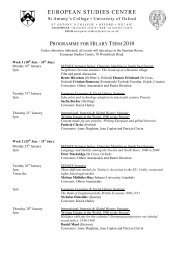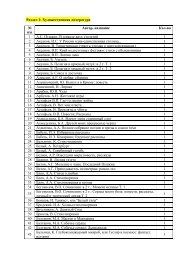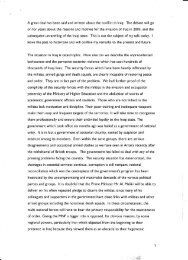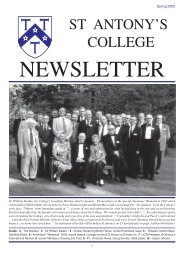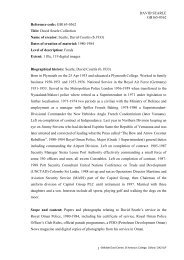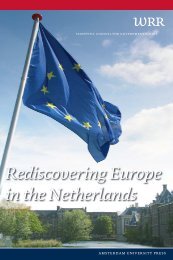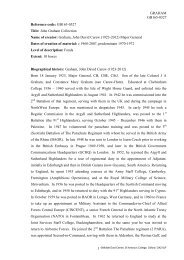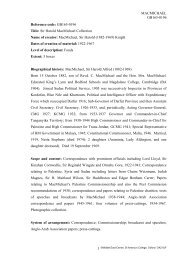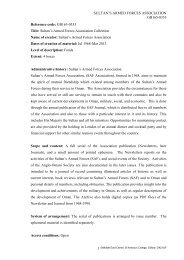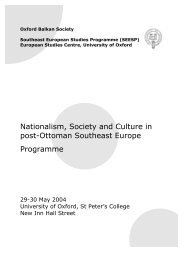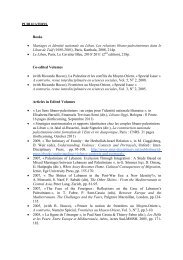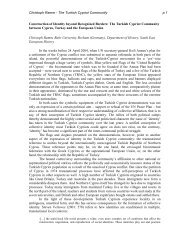Managing Migration: The Global Challenge, Population Bulletin, Vol ...
Managing Migration: The Global Challenge, Population Bulletin, Vol ...
Managing Migration: The Global Challenge, Population Bulletin, Vol ...
Create successful ePaper yourself
Turn your PDF publications into a flip-book with our unique Google optimized e-Paper software.
<strong>Managing</strong> <strong>Migration</strong>: <strong>The</strong> <strong>Global</strong> <strong>Challenge</strong><br />
socioeconomic rights for migrants in an effort to manage<br />
migration. For example, in the early 1990s, more than<br />
1,000 foreigners a day applied for asylum in Germany.<br />
<strong>The</strong> government distributed them throughout the country<br />
and required local communities to provide housing<br />
and food. But, when Germans discovered that more than<br />
90 percent of these foreigners did not need protection,<br />
there was a backlash that included attacks on foreigners.<br />
After World War II, many European governments put<br />
liberal asylum provisions into their postwar constitutions<br />
to prevent another situation in which refugees perish<br />
because other countries return them to a country that<br />
persecutes them, as happened in Nazi Germany. With<br />
the strain caused by increased migration, the German<br />
government responded in three ways. First, it required<br />
asylum seekers from countries such as Turkey to obtain<br />
visas, allowing prescreening. Second, it imposed fines on<br />
airlines that brought foreigners to Germany without visas<br />
and other documents. Third, Germany and other European<br />
Union (EU) countries agreed to make it difficult for<br />
foreigners from “safe” countries or who transited through<br />
safe countries en route to Germany to apply for asylum. 9<br />
In this way, the constitutional protection of asylum was<br />
maintained, but making it harder to apply reduced the<br />
number of asylum applicants.<br />
<strong>The</strong> United States pursued a similar strategy of restricting<br />
migrant rights in order to reduce the number of migrants<br />
entering the country. <strong>The</strong> 1993 North American Free Trade<br />
Agreement (NAFTA) was expected to speed up economic<br />
and job growth in Mexico, reducing Mexico-U.S. migration.<br />
Instead, Mexico-U.S. migration surged during a<br />
recession, prompting California voters in 1994 to approve<br />
Proposition 187, which would have denied unauthorized<br />
foreigners access to state-funded services, over the objections<br />
of almost all political leaders and opinionmakers<br />
statewide. A federal judge stopped implementation of<br />
Proposition 187, but some of its provisions were included<br />
in 1996 federal immigration reforms.<br />
Proposition 187 led to a national debate over immigrant<br />
numbers and rights, especially access to social<br />
assistance. President Bill Clinton argued that the number<br />
of needy migrants should be reduced in order to continue<br />
giving legal immigrants access to welfare benefits.<br />
Employers argued that a better solution would allow<br />
immigration to remain at high levels but reduce access<br />
to social assistance. 10 Employers won, so immigration<br />
remained high and welfare benefits were curbed. But<br />
benefits to poor children and elderly immigrants were<br />
restored during the economic boom of the late 1990s.<br />
Balancing migrant numbers and migrant rights is a<br />
major challenge. Countries with the highest shares of<br />
migrants in their labor forces, such as the oil-exporting<br />
Figure 3<br />
Economically Active <strong>Population</strong> (EAP), 1985-2015<br />
Billions<br />
World<br />
Note: 2010 and 2015 are projected.<br />
■ ■ ■ ■ ■ <br />
. . . .<br />
.<br />
.<br />
.<br />
.<br />
.<br />
.<br />
. . . . .<br />
More Developed<br />
Less Developed<br />
Source: International Labor Office, Laborsta Database (http://laborsta.ilo.org/, accessed<br />
Jan. 22, 2008).<br />
countries in the Persian Gulf, tend to extend few rights to<br />
migrants—it is very hard for a guest worker to win immigrant<br />
status and naturalize in Saudi Arabia or the United<br />
Arab Emirates. Countries with relatively fewer guest<br />
workers, such as Sweden and other Scandinavian countries,<br />
tend to grant more rights to foreigners. <strong>The</strong> tradeoff<br />
is apparent in World Trade Organization negotiations,<br />
where some developing countries argue that their migrant<br />
“service providers” should not have to earn the minimum<br />
wage in the destination country. Requiring payment of a<br />
minimum wage, they reason, will reduce the number of<br />
migrant workers. 11<br />
Regional <strong>Migration</strong> Trends<br />
Most people who cross national borders do not go far, so<br />
most international migration occurs within regions. This<br />
section reviews the most notable migration flows in the<br />
major world regions.<br />
North and South America<br />
<strong>The</strong> North American migration system includes the<br />
world’s major emigration and immigration destinations,<br />
whether defined in absolute numbers or by per capita<br />
rates: 300,000 to 400,000 Mexicans move each year to<br />
the United States, and Canada aims to increase its population<br />
by 1 percent a year through immigration. Canada<br />
and the United States represent about 5 percent of the<br />
world’s population but receive over half of the world’s<br />
anticipated immigrants. Emigration rates from many<br />
Caribbean nations are high. Jamaica, with 2.7 million<br />
residents, loses about 27,000 a year, 1 percent of its<br />
<strong>Population</strong> <strong>Bulletin</strong> <strong>Vol</strong>. 63, No. 1 2008 www.prb.org 7



